|
View as a webpage
|
  Carrizo Plain National Monument
|
|
ISSUE
823 - August 30, 2018
|
|
|
|
- Back To School
- Wildland Fire
- Headlines and Highlights
- BLM and DOI Highlights
- Wildlife Question of the Week
- Upcoming Events
|
Wishing everyone a happy and safe Labor Day Weekend! We hope you find time to visit your public lands with family and friends.
 Wild and Scenic Rivers, New Addition to the Classroom Investigation Series
Just in time for the first day of school! Wild and Scenic Rivers, a new addition to the Classroom Investigation Series, helps teachers introduce students to the 50th anniversary of the Wild and Scenic Rivers Act. As they take part in the guide's three activities, students find wild and scenic rivers, explore the history of the passage of the act and develop their own river-inspired poetry. (BLM website)
|
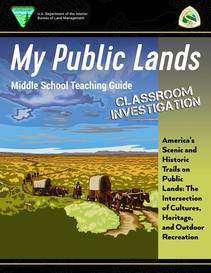 America's Scenic and Historic Trails on Public Lands: The Intersection of Cultures, Heritage and Outdoor Recreation
Just in time for the first day of school! America's Scenic and Historic Trails on Public Lands: The Intersection of Cultures, Heritage and Outdoor Recreation, the latest teaching guide in the Classroom Investigation Series, helps teachers introduce students to the 50th anniversary of the National Trails System Act. As they take part in the guide's three activities, students parse some of the act's language, use recreation.gov to locate scenic and historic trails, and read diary excerpts for diverse views on how settlers and American Indians interacted. (BLM website)
|
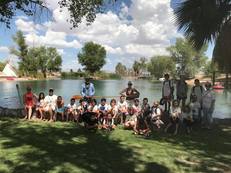 Discover the Past—Create the Future
Last month, the BLM Barstow Field Office Desert Discovery Center hosted a group of eager young summer day campers on a week long journey of Investigating Rock Art. Weaving Project Archaeology rock art lessons in with field trips, hands-on art activities and engaging presentations, students gained a deeper understanding and appreciation of their own culture as well as cultures of the past. Throughout the week, members of the Barstow Field Office, Main Street Murals, the Mojave River Valley and Redland Museums gave summer day camper’s multiple learning presentations along their investigative journey of discovery. (BLM California Facebook)
|
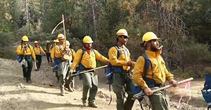 Singing Samoan Firefighters Lift Spirits in Fight Against California Wildfires
Hard-pressed firefighters in the West are getting reinforcements from some unlikely places. One unique crew traveled thousands of miles across the Pacific from American Samoa, a tropical U.S. territory about 2,500 miles south of Hawaii. As CBS News' Mireya Villarreal reports, their most powerful tool may not be a shovel or chainsaw, but the harmonic sound of their voices. (CBS This Morning)
|
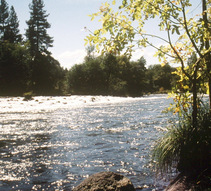 BLM Reopens Pit River Campground
The Bureau of Land Management has reopened the Pit River Campground in eastern Shasta County, as the nearby Hat Fire has been contained. The campground is five miles west of Fall River Mills, along California State Route 299. (BLM news release)
|
 BLM Recreation Sites Reopen Along the Merced River After Ferguson Fire
The Bureau of Land Management Mother Lode Field Office is reopening recreation sites along the Merced River, including McCabe Flat, Willow Placer and Railroad Flat campgrounds, since there is no longer a public safety risk in this area from the Ferguson Fire. The Briceburg Visitor Center will reopen on Friday, Aug. 17 through Labor Day Weekend. (BLM news release)
|
 BLM Reopening Cache Creek, Indian Valley and Walker Ridge After Mendocino Complex Fire
The Bureau of Land Management Ukiah Field Office is reopening the Cache Creek Management Area, which includes Cowboy Camp, Indian Valley Management Area and Walker Ridge since there is no longer a public safety risk in these areas from the Mendocino Complex Fire. (BLM news release)
|
 BLM Reopening Recreation Areas Along Clear Creek and in Cloverdale Area
Recreation sites along Clear Creek and in the Cloverdale area south of Redding have been re-opened to the public, as dangers from the Carr Fire have passed. The open areas are south of Placer Road and include the Clear Creek Gorge overlook and trails throughout the area. Recreation areas north of Placer Road, including the Swasey Recreation Area, remain closed to protect public health and safety. (BLM news release)
|

Federal, state and local leaders joined with experts to announce the results of Operation Forest Watch, a coordinated effort to address the devastating damage done to our national forests by illegal, public-land marijuana grows. This months-long effort, led by U.S. Forest Service and joined by various federal, state, county and local law enforcement agencies, as well as the California National Guard, focused on the eradication of marijuana grows on public lands and sought to remediate the environmental damage caused by such activity. (DOJ news release)
Related: Illegal marijuana grows damaging CA national forests (KCRA Channel 3 News)
|
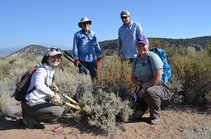 From the Field: Partners Working in Sage Grouse Habitat
Sara Kokkelenberg and Tim Bartley of Eastern Sierra Land Trust, along with Nathan Bryan and Sheena Waters of the Bureau of Land Management's Bishop Field Office, work to thin juniper seedlings in Bi-State sage grouse habitat near Bridgeport, California, Aug 23. Public and agency volunteers walked hundreds of acres of BLM and trust-owned lands for two days to remove encroaching conifers that out-compete sagebrush and other native plants for vital water and provide perches for avian predators. Pinyon pine and juniper thinning in grouse habitat is one of more than 70 projects outlined in the Bi-State Action Plan, an ongoing conservation plan managed by federal, state and local partners along the California-Nevada border to protect the species. (USFWS Pacific Southwest Region Facebook)
|
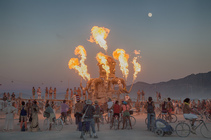 Burning Man 2018
Since 1990, the event has taken place in northwest Nevada on the Black Rock Desert playa, aka public lands managed by the Bureau of Land Management in Nevada. Event operations occupy approximately 4,400 acres of public land for 7 weeks, beginning with site preparations in early August, all the way through final clean-up in October. During the event, Black Rock City, as it is known, becomes one of the largest population centers in Nevada. (BLM Nevada Facebook)
Related: Live stream of Burning Man (burningman.org/event/live-webcast)
Related: No Spectators, The Art of Burning Man (Smithsonian American Art Museum)
|

Don’t worry about finding a dog sitter when you head out for an outdoor adventure. You can bring your furry companion along for all kinds of fun on America’s public lands. Service dogs are permitted on all public lands, while most national parks allow pets in developed areas. Other locations -- such as national wildlife refuges, national forests, and wild and scenic rivers -- also welcome pets on designated trails and parts of the backcountry at various times throughout the year. Don’t forget to check out rules and regulations for each location to know exactly where your dog is allowed. If you take your dogs on a trip into the great outdoors, make sure to always bag their waste and have a leash handy if required. This ensures you will Leave No Trace and protects your pup, wildlife, and other park goers. (DOI blog)
|
 Secretary Zinke Will Lead U.S. Delegation to the 30th Pacific Islands Forum in Nauru
U.S. Secretary of the Interior Ryan Zinke will lead a high-level U.S. government delegation—comprised of senior officials from the White House, U.S. Department of State, U.S. Department of Defense, U.S. Department of the Interior, the U.S. Coast Guard, and the U.S. Agency for International Development—to the 30th Pacific Islands Forum (PIF) Leaders Session with Forum Dialogue Partners on September 4, 2018 in Nauru. (DOI news release)
|
 True or False?
Black bears aren’t always black! In fact, they can be brown, blond, cinnamon or rust colored.
Keep reading for answer below.
|
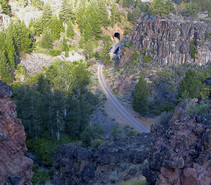 Now - October: Bus Shuttles Offered for Bizz Johnson National Recreational Trail
Weekend bus shuttle services for the Bizz Johnson National Recreation Trail started Saturday, June 2, and continue through October. The service, a partnership of the Bureau of Land Management and Lassen Rural Bus, is available to bicyclists, hikers and runners, and eliminates the need for trail users to arrange their own vehicle shuttles. On Saturdays, the bus picks up passengers at 8:15 a.m. in front of the Historic Susanville Railroad Depot, 601 Richmond Road. The bus makes stops at Devil’s Corral, Fredonyer Summit and at the Westwood Y. From these stops trail users can use the Bizz Johnson Trail for trips of 7, 18 or 30-miles back to Susanville. (BLM news release)
|
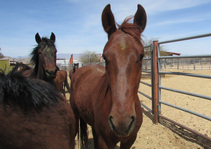 Now - 2019: Bring Home a Wild Horse or Burro
The BLM Wild Horse and Burro Program is excited to announce nearly 70 events this year as part of BLM's efforts to find good homes for our nation's wild horses and burros. Known for their intelligence, endurance and loyalty, wild horses and burros, with the right training, are outstanding for trail riding, packing, working and have successfully competed for awards in numerous fields from endurance riding to dressage. With more than 81,000 wild horses and burros on BLM-managed public lands, these wild icons of our American history need your help more than ever. Without any natural predators that can control population growth, wild horse and burro herds grow rapidly on the range and can quickly overcome the land's ability to support them. The BLM works to maintain healthy wild herds by gathering excess animals and placing them into good homes. (BLM website)
|
 August 31 - September 23: LA County Fair
Discover Los Angeles and America’s Great Outdoors at the LA County Fair in Pomona, California from August 31 to September 23. For over 20 years, a half a million people have visited the two acre outdoor site, co-managed by the BLM California Desert District, Angeles National Forest, Los Angeles County Fire Department – Forestry Division and National Park Service. Visitors are able to view animals in the BLM Wild Horse & Burro Program corral, visit an exact replica of a pre-BLM General Land Office, observe native American lifeways, watch an environmental magic show, participate in log cutting and branding, take a walk along a nature discovery trail and much, much more. We hope to see you there! (LA County Fair website)
|
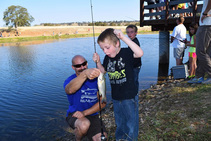 September 1: BLM to Host Veterans’ Fishing Day at the Sacramento River Bend Outstanding Natural Area
The Bureau of Land Management is hosting a free day of fishing for veterans and active duty military members from 8 a.m. to 3 p.m., Saturday, Sept. 1, at the Sacramento River Bend Outstanding Natural Area. Anglers will have access to two ponds stocked with largemouth bass, catfish and redear sunfish for a day of outdoor recreation on America’s public lands. (BLM news release)
|
|
|
WILDLIFE QUESTION OF THE WEEK ANSWER
True. Black bears come in more colors than any other North American mammal. They can be black, brown, cinnamon, blond, blue-gray, or white.
East of the Great Plains, nearly all are black. These were the first bears early settlers saw, hence the name. The melanin in black fur makes the fur resistant to abrasion in the brushy understory of eastern forests. In forested states that border the Great Plains, 5% to 25% are shades of brown rather than black. About 5% are brown in Minnesota. Blond or white individuals are rare in Minnesota, but a young white male was seen near Orr, MN, in 1997 and 1998.
In western states that have mountain meadows and open park-like forests, over half the black bears (Ursus americanus cinnamomum) are brown, cinnamon, or blond. Light colored fur reduces heat stress in open sunlight and allows the bears to feed longer in open, food-rich habitats. The lighter colored fur may also camouflage them from predators in those open areas. Ice Age predators undoubtedly used to kill black bears in open areas where the bears couldn’t escape up trees. Grizzly bears still do that in some areas today. (North American Bear Center)
|
|
|
News.Bytes
is a publication of the Bureau of Land Management in California.
Bureau of Land Management
California State Office
2800 Cottage Way, Suite W1623
Sacramento, CA 95825
(916) 978-4600
Send comments to the News.Bytes Team | Subscribe to
News.Bytes | Unsubscribe
|
     
|
|
|